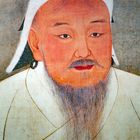Portrait of Genghis Khan
Genghis Khan as portrayed in a 14th-century Yuan era album; now located in the National Palace Museum, Ulaan Baatar.
The original version was in black and white; produced by the Mongol painter Ho-li-hosun in 1278 under the commission of Kublai Khan.
There is no definitive record of what he looked like.
For such an influential figure, very little is known about Genghis Kahn’s personal life or even his physical appearance. No contemporary portraits or sculptures of him have survived, and what little information historians do have is often contradictory or unreliable. Most accounts describe him as tall and strong with a flowing mane of hair and a long, bushy beard. Perhaps the most surprising description comes courtesy of the 14th century Persian chronicler Rashid al-Din, who claimed Genghis had red hair and green eyes. Al-Din’s account is questionable—he never met the Khan in person—but these striking features were not unheard of among the ethnically diverse Mongols.
He was responsible for the deaths of as many as 40 million people.
While it’s impossible to know for sure how many people perished during the Mongol conquests, many historians put the number at somewhere around 40 million. Censuses from the Middle Ages show that the population of China plummeted by tens of millions during the Khan’s lifetime, and scholars estimate that he may have killed a full three-fourths of modern-day Iran’s population during his war with the Khwarezmid Empire. All told, the Mongols’ attacks may have reduced the entire world population by as much as 11 percent.

















Herbert Rulf 26/01/2022 0:39
Nachkommen seiner Soldaten leben noch heute in einem Dorf in der Nähe von Tonghai in Yunnan, sie tragen die alten mongolischen Trachten, reden untereinander nur mongolisch und bauen Häuser im mongolischen Stil (keine Jurten, Häuser aus Stein).Ich war einmal dort, sehr interessant.
LG, Herbert